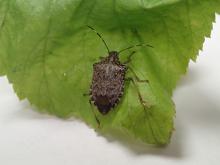Includes
Brown marmorated stink bug (Halyomorpha halys)
Consperse stink bug (Euschistus conspersus)
Green stink bug (Chinavia hilaris)
Pest description and crop damage Adult stink bugs are all shield-shaped, with a triangle-shaped section in the middle of their backs. They are generally up to about 0.5 to 0.6 inch in length. The name stink bug refers to the strong odor the insects can emit if alarmed. The consperse stink bug is pale brown, yellow underneath with red antennae. The green stink bug is bright green. The brown marmorated stink bug is brown with alternating white bands on the antennae. Nymphs are similar in shape to adults and come in a variety of colors. Stink bugs cause damage to plants by sucking sap from buds, flowers or fruits causing deformities in cherries and make the fruit unsalable. Damaged fruit is pitted, similar to hail damage. Injury usually is confined to fruit clusters or a single limb. Damage may not be visible until fruit begins to ripen.
Biology and life history Adults overwinter in groundcover. They feed early in the season on weeds and may move later into other host plants. Stink bug damage is the worst in dry summers, when alternative hosts are dried up.
For further biology and life history as well as sampling and biological control
See:
Brown Marmorated Stink Bug: An Emerging Threat to Pacific Northwest Agriculture
Management-chemical control: HOME USE
- azadirachtin (neem oil)-Some formulations are OMRI-listed for organic use.
- carbaryl-Highly toxic to bees: do not apply during bloom.
- esfenvalerate-Highly toxic to bees.
- gamma-cyhalothrin-Highly toxic to bees.
- imidacloprid-Soil drenches may have residual activity in woody plants lasting for 12 or more months. If short-term management is the goal, consider other approaches.
- kaolin clay (Surround at Home)-Repels some insect pests when applied as a spray to leaves, stems, and fruit. OMRI-listed for organic use.
- lambda-cyhalothrin-Highly toxic to bees.
- pyrethrins-Some formulations are OMRI-listed for organic use. Highly toxic to bees.
- zeta-cypermethrin-Highly toxic to bees.
Management-chemical control: COMMERCIAL USE
Growing-season spray
- esfenvalerate (Asana XL) at 4.8 to 14.5 fl oz/A. REI 12 hr. PHI 14 days. Treat in April. Extremely toxic to fish and aquatic invertebrates; avoid spray drift and runoff to surface waters.
- kaolin clay (Surround WP) at 25 to 50 lb/A. REI 4 hr. No PHI listed. Repels some insect pests when applied as a spray to leaves, stems, and fruit. OMRI-listed for organic use.
- lambda-cyhalothrin (Warrior II) at 1.28 to 2.56 fl oz/A. REI 24 hr. PHI 14 days. May disrupt beneficial mite populations. Extremely toxic to fish; avoid spray drift and surface runoff.
- thiamethoxam (Actara) at 4.5 to 5.5 oz /A. REI 12 hr. PHI 14 days. Actara is extremely toxic to bees exposed to direct treatment or residues. Do not apply Actara between the pre-bloom (swollen bud) and post-bloom (petal fall) growth stages. Do not exceed a total of 11.0 oz/A (0.172 lb ai/A) of Actara or 0.172 lb ai of thiamethoxam-containing products per acre per growing season.


